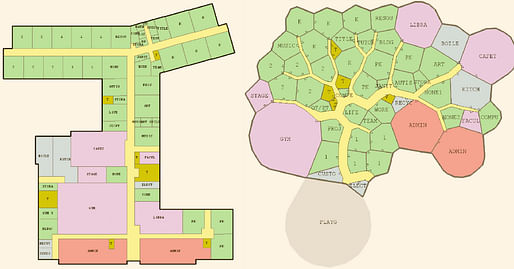

Recent computational tools that model the simulation of traffic, acoustics and heat conservation, among others, are allowing a more quantitative objective evaluation of forms.
The metrics could be expanded to include terrain maps, sun paths, existing trees and other environmental input, allowing the buildings to be highly adaptive to their context. The physics simulation could force certain boundary shape constraints.
— Joel Simon
Evolving Floorplans is an experimental research project created by a New York-based programmer, Joel Simon. When approaching floorplan design solely through the angle of optimization, a genetic algorithm arranges the rooms and the flow of people in a manner that minimizes things like walking time, the use of hallways, etc. The layout 'grows' from the encoding using methods such as graph contraction and ant-colony inspired algorithms, resulting in something 'biological in appearance, intriguing in character, and wildly irrational in practice'.
This is why nobody is actually worried that computers are going to take over anytime soon.
All 13 Comments
Resistence is futile. You will be assimilated.
Only works alongside the property-line-adjusting algorithm.
Each sold separately.
Wot about sunlight?
what is this supposed to accomplish. Can we get a metric on air health quality or fire related deaths or what.
Typical USA academia: "It's totally useless in real life, but it makes an interesting graphic."
There's so much wrong with this, it's hard to think of where to start. Minimizing one variable without worrying about literally anything else is simple-minded in the extreme. Now if they optimized travel distance, air and light access together with material usage and interior space efficiency, they'd have my full attention.
at first look i wonder how the furniture would be arranged in the blob. wider corridors based on volume of traffic is an interesting idea, but they can't get too thin or cross traffic would become uncomfortable and it might not meet egress widths. all the bumps and angles on the exterior wall will drive up the price and make the roof a little more difficult to drain. the computer separated the cafeteria and gym. seems to me the human put those next to each other for a reason.
The idea here is powerful but not fully worked out. They should have proceeded to add in further parameters like building codes, energy use, and interior furnishings and made it a more useful tool.
This guy's stuff is not really new. SOM did something similar to this in the 1970's. It was called Building Optimization System (BOPS).
This is why nobody is actually worried that computers are going to take over anytime soon.
+1
Quantitative analysis, not qualitative.
MBA think.
From eight external exits to two? I hate to imagine a fire with black smoke in those hallways cutting off visibility and everybody trying to get out of the maze.
It's more interesting when algorithmic tools augment human intuition and logic rather than subsuming it.
Having designed numerous custom homes in the past, I can safely say that the design as shown with the "intelligent" computer will cost at least five times more to build because every wall, roof, and utility installation will have to be custom cut and installed. Labor costs alone will add at least 200% additional cost.
Block this user
Are you sure you want to block this user and hide all related comments throughout the site?
Archinect
This is your first comment on Archinect. Your comment will be visible once approved.